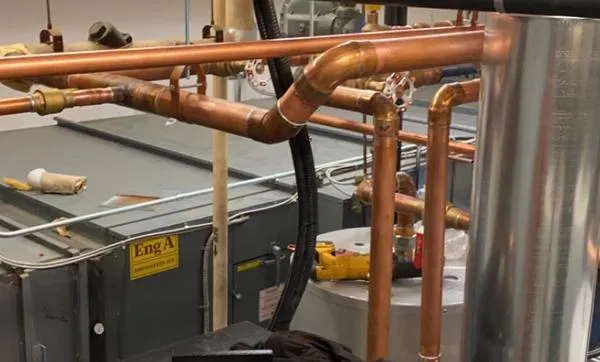
Commercial Plumbing Upgrades That Benefit Edmonton Businesses
Running a business is already full of operational headaches—plumbing shouldn’t be one of them. But outdated commercial plumbing systems lead to frequent repairs, high utility bills, and disruptions that cost real money. For Edmonton businesses, upgrading your plumbing infrastructure can provide not just reliability but long-term savings, better performance, and competitive advantage.
In this article, we’ll explore the plumbing upgrades that deliver value to commercial properties in Edmonton: what to upgrade, the benefits, how to prioritize, and what questions to ask your plumber before starting.
Why Commercial Plumbing Upgrades Matter
Commercial buildings have higher demands than a residential property: more occupants, more equipment, heavier usage of restrooms, kitchens, laundries, or specialty systems. Older plumbing systems weren’t always designed for today’s loads or regulatory standards. Over time, wear, corrosion, mineral buildup, and shifts in building use degrade system performance and push up costs.
Upgrades matter because they:
reduce breakdowns and downtime
lower utility costs
improve customer and staff experience
ensure code compliance
increase the property’s value
future-proof infrastructure as business grows
In short, plumbing is part of your building’s backbone. It needs to perform reliably, quietly, and efficiently.
Key Commercial Plumbing Upgrades to Consider
Here are upgrade options often worth considering for Edmonton commercial buildings:
Modern, High-Efficiency Fixtures
Upgrading toilets, urinals, faucets, and showerheads to water-efficient or sensor/auto fixtures reduces water use while maintaining performance. In high-traffic facilities, this can produce big savings on water bills and reduce strain on drainage systems.
Smart Leak Detection & Monitoring Systems
Installing sensors that monitor flow, pressure fluctuations, or sudden spikes in usage can detect leaks early—before they cause damage or waste thousands of litres. These systems can send alerts in real time, helping facility management act swiftly.
Pipe Replacement & Repiping with Durable Materials
Older pipes (galvanized steel, cast iron, etc.) tend to corrode, scale, or develop weak spots. Upgrading to corrosion-resistant materials (PEX, upgraded copper, advanced plastics) reduces leak risk, improves flow, and lowers long-term maintenance.
Improved Drainage, Trenching, and Backflow Prevention
Upgrading drainage lines, trenching to better slope, adding catch basins, or installing modern backflow prevention devices protects your building from flood risks, sewer backups, and regulatory issues.
Upgraded Water Heating Systems
Commercial-grade water heaters, tankless or hybrid systems, or properly sized high-capacity units can better meet demand while improving energy efficiency. Retrofitting or resizing your water heater system reduces wait times for hot water and energy waste.
Wastewater / Greywater Recycling Systems
In buildings with high water usage, investing in greywater systems or reuse configurations for toilets, irrigation, or cooling systems can reduce potable water demand and offer a sustainable, cost-saving edge.
Pressure Booster Systems & Pressure Zoning
In large or multi-story commercial buildings, pressure loss in upper floors is common. Upgrading with pressure booster pumps, zone control valves, or variable speed pumping ensures even, adequate pressure everywhere.
Fixture Redundancy & Bypass Systems
Adding redundant lines, parallel fixtures, isolation valves, or bypass lines allows repair or maintenance with minimal disruption to business operations.
Integration with Building Management Systems (BMS)
Connecting plumbing subsystems (water, leaks, flow) into your BMS or facility automation lets you monitor and adjust systems in real time, schedule maintenance, and optimize resource use.
How to Plan & Prioritize Plumbing Upgrades
To make the most of your investment, here’s a step-by-step decision framework:
Step 1: Audit Existing Systems
Inspect the condition, age, materials, pressure, leak history, and usage patterns of plumbing assets. Use video inspection tools where needed.Step 2: Identify High-Impact Pain Points
Which issues cause the most disruption, repair cost, or water/energy waste? Start upgrades there (e.g. frequent leaks, high water bills, pressure complaints).Step 3: Estimate ROI & Payback
Compare upgrade cost vs expected savings (water, energy, repair). Prioritize projects that yield quick payback or reduce catastrophic risk.Step 4: Ensure Code Compliance & Permits
Review Edmonton municipal plumbing, health, and water regulations. Some upgrades may require permits or must meet specific metrics.Step 5: Plan for Phased Implementation
Avoid shutting down your facility. Stagger upgrades, maintain critical operations, use redundancy or temporary systems where possible.Step 6: Work with Experienced Commercial Plumbers
Choose a plumbing team with commercial experience in Edmonton—who understand local climate, codes, and commercial usage scenarios.Step 7: Monitor & Maintain
After installation, maintain regular inspections, sensor alerts, and scheduled servicing to protect your investment and performance.
FAQs
Q: How much does a commercial plumbing upgrade cost?
It varies widely depending on scale, materials, and complexity. Some upgrades (fixtures, monitoring) may cost relatively little; full repiping or system overhaul for large buildings may be significant capital expense.Q: Will upgrading plumbing disrupt my business operations?
Yes, potentially. That’s why phased implementation, redundancy, and working during off hours are critical planning steps to minimize disruption.Q: How long until I see savings?
In many cases, water/energy savings begin immediately. Major investments like repiping or system upgrades might take months to several years to pay back, depending on usage patterns.Q: Which upgrades provide the greatest impact first?
Usually leak detection systems, efficient fixtures, and pipe replacement in high-issue zones yield the fastest returns.Q: Do I need to upgrade plumbing if my building is new?
Even new buildings may benefit if the design is conservative or future growth is expected. Smart systems and scalable plumbing design are worthwhile from the start.
Conclusion
Commercial plumbing upgrades are strategic investments, not just repairs. For Edmonton businesses, improving fixtures, piping, leak detection, water heating, drainage, and integration with automation can reduce costs, boost reliability, and improve tenant or customer experience.
If your building’s plumbing is causing headaches or limiting your capacity, working with a commercial plumbing specialist in Edmonton can help you target upgrades that deliver measurable returns and peace of mind.